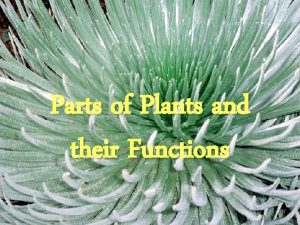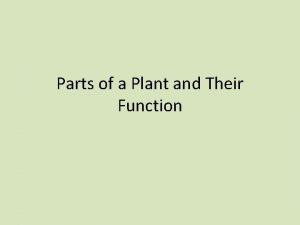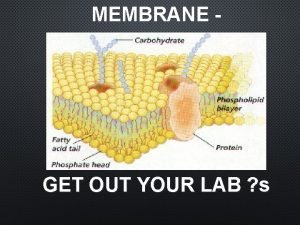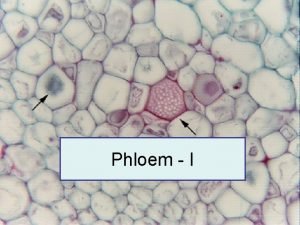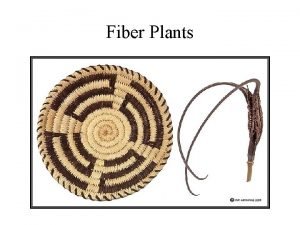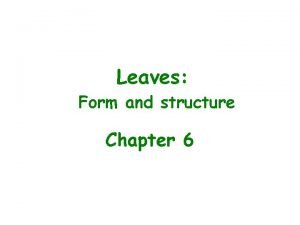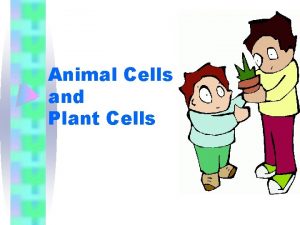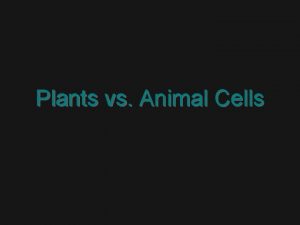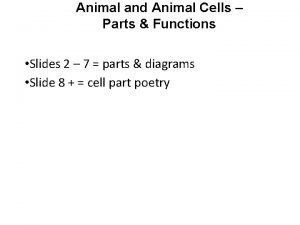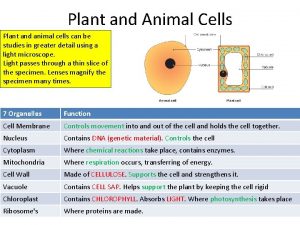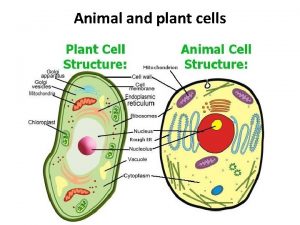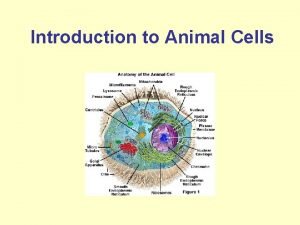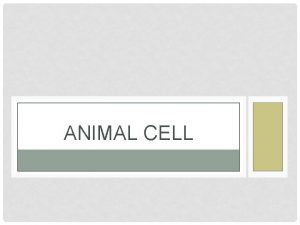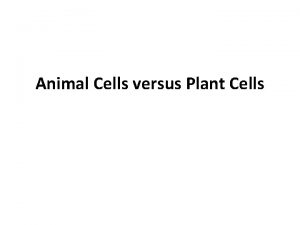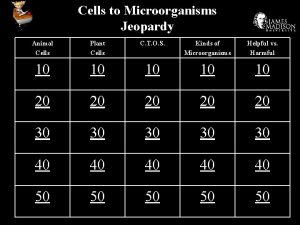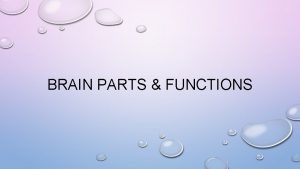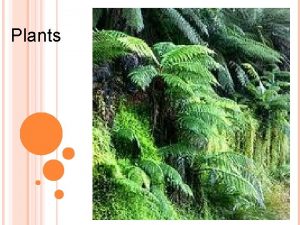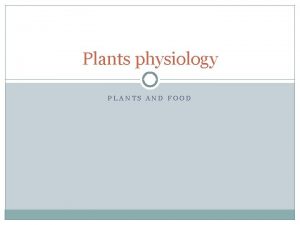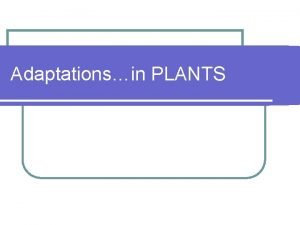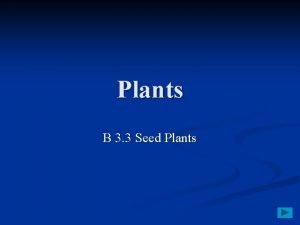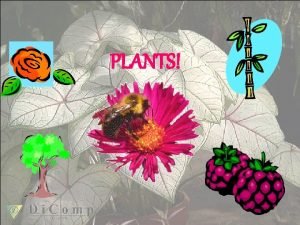CELLS Functions of each Parts PLANTS AND ANIMAL


























- Slides: 26

CELLS

Functions of each Parts PLANTS AND ANIMAL CELLS Parts of Plant and Animal Cells Differences between Plant and Animal Cells

�From the key vocabulary, circle the words that you can already define or use in a sentence. �Write down two or three things that you think are important for you to know today.

�The study of living things �What is considered living? �anything that has the ability to nourish, grow, and reproduce �cells must be present

�The cell is considered the basic unit of life. �All living things contain at least one cell. �Cells come from pre-existing cells.

1. What structures can be identified in a typical animal or plant cell?

PLANT CELL ANIMAL CELL

PLANT CELLS • cell wall (provides structure) • chloroplast (location of photosynthesis/ energy production) ANIMAL CELLS • centrioles (responsible for cell reproduction)

ORGANELLES STRUCTUR E FUNCTION nucleus control of all cell activities; location of DNA mitochondri a Golgi complex (apparatus) ribosome energy production assembles, sorts, and transports cell products protein synthesis chromosom composed of DNA containing genetic e material

STRUCTUR E cell membrane FUNCTION phospholipid bilayer; maintains homeostasis; protects the cell digests old cells and food (cleans up lysosome the cell) endoplasmic produces, stores, and transports reticulum protein (rough) and lipids (smooth) flagella/cilia movement of materials

2. Compare prokaryotic and eukaryotic cells.

�No true nucleus �No membrane-bound organelles �No well-organized membrane

�All prokaryotes are bacteria and all bacteria are prokaryotes �Prokaryotes = bacteria (Monera)

�True nucleus �Well organized membrane �Membrane – bound organelles

�Most plants and animals and other specialized organisms

3. Compare and contrast active and passive transport in at least 4 ways.

ACTIVE TRANSPORT • requires energy (low concentration to high) • endocytosis and exocytosis • active transport (ATP is used) PASSIVE TRANSPORT • diffusion (particles from high concentration to low) • osmosis (water from high concentration to low) • facilitated transport (diffusion using a membrane protein)

4. Define each of the following: carbohydrates, lipids, proteins, and nucleic acids.

ORGANIC DEFINITION FUNCTION COMPOUND sugars and provide carbohydrates starches energy fats (insoluble lipids store energy in water) responsible proteins amino acids for most cell functions store DNA and hereditary nucleic acids RNA

5. Describe the role of the cell membrane in maintaining homeostasis.

�The maintenance of a constant, stable environment internally example: body temperature

HOMEOSTASIS �utilizes active and passive transport �diffusion and osmosis depends on environment (hydrophobic or hydrophilic)

Hydrophobic Hydrophilic • “waterfearing” loving” • outside of cell • inside of cell

�If the cell were a community, what components would a cell have to function as a community? (boundaries— political, transportation, energy source)

�Write a sentence that explains the system discussed. �Draw a graphic organizer that shows the relationship of the cell parts to the whole cell.

1. 2. 3. 4. 5. A cell provides structure and function for an organism. Cells are the “building blocks” of life. Energy is produced in the mitochondria of cells. The cell membrane consists of a double layer of lipids and phosphate groups (a phospholipid bilayer). Because water is polar and lipids are non-polar, the cell does not dissolve in water. Homeostasis is the ability of an organism to maintain a balanced and constant environment. Pro-no true nucleus or membrane-bound organelles, and Eu-true nucleus and membrane-bound organelles
 Animal rights and animal welfare venn diagram
Animal rights and animal welfare venn diagram Objectives of plant format
Objectives of plant format What are the six main parts of a plant
What are the six main parts of a plant Four basic parts of a plant
Four basic parts of a plant Digestive system of ruminants
Digestive system of ruminants Development of paranasal sinuses
Development of paranasal sinuses Red blood cells and white blood cells difference
Red blood cells and white blood cells difference Masses of cells form and steal nutrients from healthy cells
Masses of cells form and steal nutrients from healthy cells What cells need isotonic solutions to be at homeostasis
What cells need isotonic solutions to be at homeostasis Characteristics of non-flowering plants
Characteristics of non-flowering plants Papillary duct of bellini
Papillary duct of bellini Parafollicular
Parafollicular Gametic cells vs somatic cells
Gametic cells vs somatic cells Why dna is more stable than rna?
Why dna is more stable than rna? Prokaryotic and eukaryotic cells worksheet
Prokaryotic and eukaryotic cells worksheet Prokaryotic cell
Prokaryotic cell Cell organelle jeopardy
Cell organelle jeopardy Younger cells cuboidal older cells flattened
Younger cells cuboidal older cells flattened What cell type
What cell type Which compares prokaryotes and eukaryotes
Which compares prokaryotes and eukaryotes Chapter 8 cellular reproduction cells from cells
Chapter 8 cellular reproduction cells from cells Cell substance
Cell substance Sieve cells and sieve tubes
Sieve cells and sieve tubes Photosynthetic cells
Photosynthetic cells Fiber cells in plants
Fiber cells in plants Seedless nonvascular plants
Seedless nonvascular plants A specialized leaf
A specialized leaf

